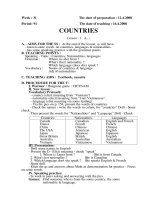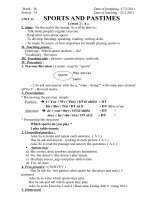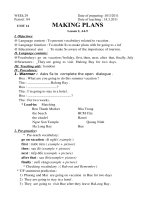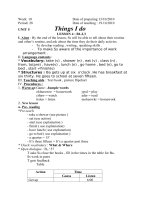- Trang chủ >>
- Đề thi >>
- Đề thi lớp 6
tuchon10 tiet 1234
Bạn đang xem bản rút gọn của tài liệu. Xem và tải ngay bản đầy đủ của tài liệu tại đây (130.92 KB, 11 trang )
<span class='text_page_counter'>(1)</span><div class='page_container' data-page=1>
<b>Date of writing: August 24</b>th<sub>, 2010</sub>
<b> Lesson 1: SCHOOL TALKS</b>
<b>A. Objectives:</b>
By the end of the lesson, ss will be better at reading skill.
<b>B. Teaching aids: Handouts</b>
<b>C. Teaching method: Integrated/ mainly communicative</b>
<b>D. Procedure:</b>
I. Organization:
<b>Class Date of</b>
<b>teaching</b>
<b>Absent students</b>
10A1 August
28th <sub>,</sub>
2010
………
10A2 August
28th <sub>,</sub>
2010
………
10A3 August
28th <sub>,</sub>
2010
………
<i><b>II. New lesson:</b></i>
Step 1: Before you read
- Ask Ss to answer some questions
1. How many students are there in your class?
2. What lesson do you like most? And what lesson are you good at?
3. Are you worried about exams? Why (not)?
- Get the answers from Ss.The answers may vary
Step 2: While you read
<i><b>Task 1: Choosing the best answer to the questions.</b></i>
- Ask Ss to read the passage and do the task individually.
Chantal’s parents didn’t have much money so they sent her to a state
primary school when she was five. She enjoyed her reading and writing
lessons, but there were so many pupils in the class that the teacher found it
difficult to control them.
When Chantal was eleven, her father got a better job, and decided to
spend some money on her education. He sent her to an expensive private
school, where the girl wore dark green uniforms and did two hours’
homework every evening.
</div>
<span class='text_page_counter'>(2)</span><div class='page_container' data-page=2>
course and was an excellent student. In the end she decided to become a
teacher, and returned to her old primary school to teach.
1. Why did Chantal’s parents send her to a state school?
A. They liked it B. It was near her house
C. They were poor D. It was expensive
2. How many kinds of lessons did she like learning?
A. 3 B. 1 C. 4
D. 2
3. What was her teacher’s problem at the primary school?
A. large class B. low salary C. disobedient pupils D. strict
head master
4. It can be inferred from the passage that the state school is
_________than the private school.
A. cheaper B. more expensive C. better D.
better equipped
5. What profession did she finally decide to choose?
A. cooking B. teaching C. nursing D.
advertising
- Let them exchange their ideas with a partner for peer correction.
- Get the answers from Ss and get comments from the others.
- Feedback and give final comments
<b>Correct answers:</b>
1. C 2.D 3.A 4.A 5.B
<i><b>Task 2: Circle the best option to fit each space</b></i>
- Ask Ss to read the passage and do the task individually.
It’s important to eat well when you’re (1) ______. If you are at (2) _____,
you may go home for lunch, and have a cooked meal of (3) _____ or fish
and vegetables. Or perhaps you take some food with you to school, and eat
it in the lunch (4) _____. A chicken and lettuce sandwich, with some fresh
(5) _____, would be a light but healthy lunch. Many people around the
world eat plain, (6) _____ rice two or three times a day.
Pupils and (7) _____ often don’t eat well when they’re (8) _____ for an
exam- they eat chocolate and drink lots of black coffee! And by the way,
doctors say everybody should start the day with a healthy (9) ______. It’s
also good for you to drink a lot of (10) ____ right through the day.
1.A. student B. study C. studying D. studied
2.A. school B. primary C. office D. class
3.A. cheese B. meat C. fruit D. seafood
4.A. timetable B. classroom C. lesson D.break
</div>
<span class='text_page_counter'>(3)</span><div class='page_container' data-page=3>
6.A. boiled B. baked C. grilled D. roast
7.A. teachers B. professors C. students D. boys
8.A. reviewing B. reading C. learning D. revising
9.A. dinner B. breakfast C. lunch D. supper
10.A. water B. coffee C. tea D. coke
- Let them exchange their ideas with a partner for peer correction.
- Get the answers from Ss and get comments from the others.
- Feedback and give final comments
<b>Correct answers:</b>
1. C 2.A 3.B 4. D 5. B 6.A 7.C 8.D 9.B
10.A
Step 3: After you read
- Ask Ss to talk about the problems they have at school
- Call on some Ss to give their problems
- Get comments from the others.
- Feedback and give final comments
<i><b>III. Summary:</b></i>
- Summarize the main point of the lesson.
<i><b>IV. Homework: </b></i>
- Prepare for speaking lesson (the ways to greet)
<b>E. Evaluation:</b>
...
...
...
===============******=============
<b> Date of writing:</b> September
15th<sub>, 2010</sub>
<b> Lesson 2: Writing about peoples’ background</b>
<b>A. Objectives: </b>
By the end of the lesson, ss will be better at writing a background
<b>B. Teaching aids: Hand-outs.</b>
<b>C. Method: Intergrated and mainly communicative.</b>
<b>D. Procedure:</b>
<i><b>I. Organization: </b></i>
<b>Class Date of</b>
<b>teaching</b>
<b>Absent students</b>
10A1 September
</div>
<span class='text_page_counter'>(4)</span><div class='page_container' data-page=4>
10A2 September
18th<sub> , 2010</sub>
……….
10A3 September
22nd<sub> , 2010</sub>
……….
<i><b>II. New lesson:</b></i>
<i><b> Activity 1: Matching </b></i>
- Ask sts to work in pairs to match the names of the people with their
relevant information.
<b>A</b> <b>B</b>
1. Ho Chi Minh
2. Washington
3. Louis Pasteur
4. Shakespeare
5. Pele
6.Leonardo de Vinci
7. Beethoven
8. Bill Gates
a. the world-famous French chemist.
b. the Brazilian football player.
c. the President of the USA.
d. the Italian artist.
e. the general manager of the Microsoft.
f. the leader of the Vietnamese
Communist party.
g. the German music composer.
h. the famous English playwright.
- Go round to observe and provide help if needed.
- Call on some sts to give their answers and get comments from the others.
- Feedback and give final comment.
<i><b>Answers: </b></i>
1. f 2. c 3. a 4. h 5. b 6. d 7. g 8. e
- Ask sts whether they know anything about Uncle Ho
+ Where and when he was born
+ How he got basic education
+ What he did in 1911.
+ What he did in 1941.
+ What he did on September 2nd<sub>, 1945</sub>
+ What happened to him on September 2nd<sub>, 1969.</sub>
- Get the answers from sts if possible
<i><b>Activity 2: Writing complete sentences with the given cues</b></i>
1. Uncle Ho/ bear/ May 19th<sub> , 1890/ Nam Dan- Nghe An</sub>
2. He/ be/ youngest of the three children.
3. He / receive/ basic education/ his father and the local village school.
4. 1911/ he/ find/ work/ kitchen hand on a French steamer travelling
from Sai Gon to Marseilles.
</div>
<span class='text_page_counter'>(5)</span><div class='page_container' data-page=5>
6. September 2nd<sub>, 1945/ he read / Vietnamese declaration of</sub>
Independence/ Ba Dinh Square/ and / become/ first president / an
independent Vietnam.
7. 1954/ he / lead/ Vietnamese Army to the victory/ Dien Bien Phu.
8. September 2nd<sub> , 1969/ he die/ Hanoi/ age of 79.</sub>
- Go round to observe and provide help if needed.
- Call on some sts to show their writing on the board.
- Get comments from other sts.
- Feedback and give final comment.
1. Uncle Ho was born on May 19th<sub>, 1890 in Nam Dan Nghe An.</sub>
2. He was the youngest of the three children.
3. He received his basic education from his father and the local village
school.
4. In 1911, he found work as a kitchen hand on a French steamer
travelling from Sai Gon to Marseilles.
5. In 1941 he returned to Vietnam and took many political activities.
6. On September 2nd<sub>, 1945 he read the Vietnamese declaration of</sub>
Independence at Ba Dinh Square.
7. In 1954, he led the Vietnamese Army to the victory at Dien Bien Phu.
8. He died on September 2nd<sub>, 1969 in Ha Noi, at the age of 79. </sub>
<i><b>III. Summary :</b></i>
- Summarize the main point of the lesson: Information of a background/
tenses
<i><b>IV. Homework: </b></i>
- Revise past simple and past perfect( forms and usage)
<b>E. Evaluation:</b>
...
...
... ...
...
...
===============******=============
<b>Date of writing: September 19</b>th<sub> , 2010</sub>
<b> Lesson 3: Past simple/ past perfect</b>
<b>A. Objectives: </b>
By the end of the lesson, ss will be better at using past simple and past
perfect
<b>B. Teaching aids: Hand-outs.</b>
</div>
<span class='text_page_counter'>(6)</span><div class='page_container' data-page=6>
I. Organization:
<b>Class Date of</b>
<b>teaching</b>
<b>Absent students</b>
10A1 September
24th<sub> , 2010</sub>
………..
10A2 September
22nd<sub> , 2010</sub>
……….
10A3 September
24th<sub> , 2010</sub>
……….
<i><b>II. New lesson:</b></i>
<i><b>Activity 1: Complete each sentence with the correct tenses of the verbs in</b></i>
<i><b>brackets</b></i>
- Ask sts to work in groups to do the task
1. When we arrived, the dinner _________________( already begin).
2. She ____________( cry) after he ______________( go).
3. They __________( tell ) us we __________( be) late. The train
_________( leave).
4. He thanked me for what I ________________( do).
5. After they had gone, I ___________( sit) down and
___________( rest)
6. My friend _______________( not see ) me for many years when I met
him.
- Go round to provide help if needed.
- Call on some sts to give their answers and get comments from the
others.
- Feedback and give final comment
<b>Correct answers:</b>
1. had already begun 2. cried – had gone
3. told – were – had left 4. had done
5. sat - rested 6. hadn’t seen
<i><b>Activity 2: Finding and correcting the mistakes.</b></i>
- Ask sts to work in groups to find out one mistake in each sentence and
then correct it.
1. She (A) was sad (B) after she (C) reads her (D) boyfriend’s letter.
2. (A) After she (B) had had lunch, she (C) had taken (D) a nap.
3. Mary (A) had live in London (B) for five years before she (C) moved
(D) to New York.
</div>
<span class='text_page_counter'>(7)</span><div class='page_container' data-page=7>
5. This (A) is not the first time we (B) have talked to (C) each other. I
(D) had met George five months ago at Jennifer’s party.
6. (A) By the time they (B) had come, the food (C) had already got (D)
cold.
_ Get the answers from sts and comments from the others.
- Feedback and give final comment.
<b>Correct answers:</b>
1. C ( had read) 2. C ( took) 3.A ( had lived)
4. D ( arrived) 5. D ( met) 6. B( came)
<i><b>III. Summary :</b></i>
- Summarize the main point of the lesson: the usage of past simple and
past perfect
<i><b>IV. Homework: </b></i>
- Prepare for speaking lesson( the ways to greet)
<b>E. Evaluation:</b>
...
...
... ...
...
...
===============******=============
<b> Date of writing:</b> September
25th<sub>, 2010</sub>
<b> Lesson 4: Reading: Special Education </b>
<b>A. Objectives: </b>
By the end of the lesson, ss will be better at reading skill
<b>B. Teaching aids: Hand-outs.</b>
<b>C. Method : Intergrated and mainly communicative.</b>
<b>D. Procedure:</b>
I. Organization:
<b>Class Date of</b>
<b>teaching</b>
<b>Absent students</b>
10A1 October 1st<sub> ,</sub>
2010
………..
10A2 September
29th<sub> , 2010</sub> ……….
10A3 October 1st<sub> ,</sub>
2010
</div>
<span class='text_page_counter'>(8)</span><div class='page_container' data-page=8>
<i><b>II. New lesson:</b></i>
<i><b>Task 1: Read the text and questions below. For each question, circle the</b></i>
<i><b>letter you choose A, B, C or D.</b></i>
- Ask sts to work in groups to do the task
Louis Braille was born in France in 1809. His father had a small business.
He made shoes and other things from leather. Louis liked to help his father
in the store even when he was very small. One day when Louis was 3 years
old, he was cutting some leather. Suddenly the knife slipped and hit him in
the eye. He soon became completely blind. When he was ten years old, he
entered the National Institute for the blind in Paris. One day his class went to
visit a special exhibit by a captain in the army. One thing in the exhibit was
very interesting for Louis. It showed message in code. Armies send
messages in secret codes so no one else can read them. The captain wrote
this code in raised letters on very thick japer.
Louis thought a lot about this code. Then he decided to write in the same
way so the blind could "read" with their fingers. It is very difficult to feel the
differences between raised letters. Instead of letters, Louis used a "cell" of
six dots. He arranged the dots with two dots across and three down. So blind
people can read and write even write music by Braille.
1. <i>Louis Braille's father made things from...</i>
A. leather B. wool C. exhibit
D. codes
2. <i>When Louis was ten years old. he began to study...</i>
A. at a local school B. at a university
C. at a special school for the blind D. in the army
3. <i>He saw a special exhibit. It showed...in code.</i>
A. messages B. systems C. arrangements D.
computers
4. <i>It is difficult to feel the differences between...</i>
A. coded messages B. arrangements of dots
C a system of raised dots D. raised letters
5. <i>Which of these sentences is probably not true?</i>
A. Braille invented a system of reading for blind people.
B. Braille visited an exhibit of codes.
C. Braille system is used for everyone.
D. Louis Braille was an intelligent boy.
- Go round to observe and provide help if needed.
</div>
<span class='text_page_counter'>(9)</span><div class='page_container' data-page=9>
- Feedback and give final comment.
Correct answers.
1. A 2. C 3. A 4. D 5. C
<i><b>Task 2: Read the text and questions below. For each question, circle the</b></i>
<i><b>letter you choose A, B, C or D.</b></i>
In 1816, there were no schools for the deaf in this country. Several people
<b>attempted to start schools, but all of the school closed. There were too many</b>
problems. The first people to succeed were Laurent Clerc and Thomas
Hopkins Gallaudet. They opened their school in 1817, and the school did not
close. It was named the Connecticut Asylum for the Education and
Instruction for Deaf and Dumb Persons. It was the only school for deaf
children in America!
Clerc and Gallaudet did not know what would happen after they opened
their school. They worked very hard. The school grew, and many more
students enrolled. These new students were from all over the country.
People thought the school would be big enough for all of the deaf children in
America. The school is still open today, but the name was changed. Today it
is called The American School for the Deaf. It is in West Hartford,
Connecticut.
1. The word “Attempted “in line 1 can be replaced by ………….
A. agreed B. planned C. wanted
D. tried
2. Laurent Clerc and Thomas Hopkins Gallaudet are those who
………
A. opened the first school for deaf people in 1816
B. had problems opening the school for deaf people.
C. were successful in opening the school for deaf people.
D. changed the name of their school.
3. The word “enrolled “in line 8 can be best replaced by ………
A. joined B. liked C. visited
D. worked
4. What is true about the American School for the Deaf?
A. It is the only school for deaf children in America.
B. It was opened in 1816
C. Its students are from Connecticut only
D. It started as a small school and became bigger.
5. What can be the best title for the passage?
A. Laurent Clerc and Thomas Hopkins Gallaudet.
</div>
<span class='text_page_counter'>(10)</span><div class='page_container' data-page=10>
D. The American School for the Deaf
- Ask sts to do the task in groups.
- Go round to observe and provide help if needed.
- Get the answers from some sts and comments from the others.
- Feedback and give final comments.
1. D 2. C 3. A 4. D 5.
D
<i><b>Task 3: Read the following passage and then circle the corresponding</b></i>
<i><b>letter A, B, C or D to fill in each gap.</b></i>
- Ask sts to work in groups to do the task.
The special (1) _______ of people with disabilities (2) _____considered by
the education (3) _____ and appropriate services (4) _____. For example, (5)
_______blind would benefit from access (6) ______ computers which
convert text to (7) _____. The (8) _______ may need special tutors skilled
(9) _____sign language. The goal, however, would be the integration of the
disabled into the regular school system (10) ______ maintaining these
services.
1.A. needs B. demand C. requirement D. questions
2.A. to be B. must be C. be D. being
3.A. class B.group C. system D. team
4.A. lent B. borrowed C. sold D. provided
5.A. the B. a C. an D. X
6.A. on B. in C. to D. by
7.A. word B. voice C. language D. letter
8.A. deaf B. blind B. rich D. poor
9.A. of B. on C. in D. with
10.A. although B. in spite C. during D. while
- Get the answers from some sts and get comments from the others.
- Feedback and give final comment
1. A 2.B 3. C 4. D 5. A 6. C 7. B 8. A 9.
C 10. D
<b>*) Homework:</b>
Ask ss to read the tests again and summarize them and prepare for
Unit 4- Speaking.
<b>V. Evaluation:</b>
</div>
<span class='text_page_counter'>(11)</span><div class='page_container' data-page=11></div>
<!--links-->









